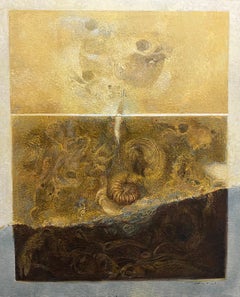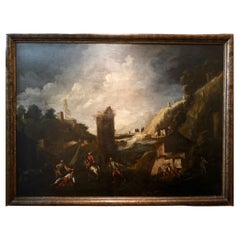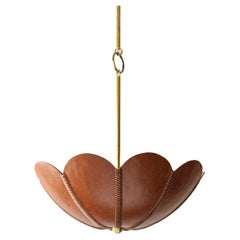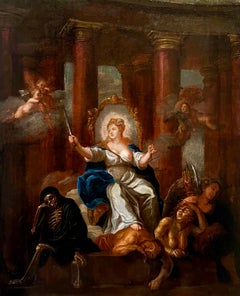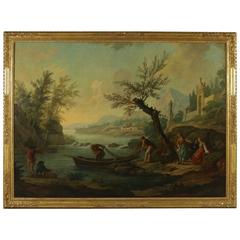Ruggeri Oil Painting
"Fossils and shells" Oil cm. 100 x 120 Yellow, Brown 1960
Located in Torino, IT
gallery in Milan, together with Merz, Ruggeri and Saroni.
He participates in the 1956, 1958, 1964 and 1972
Category
1960s Abstract Abstract Paintings
Materials
Canvas, Oil
H 47.25 in W 39.38 in
18th Century by Gaspare Diziani Venus With Cupid Oil on Canvas
By Gaspare Diziani
Located in Milano, Lombardia
cassetta frame
Expertise: Ugo Ruggeri
The narration of our canvas opens in a delightful and serene marine
Category
Early 18th Century Old Masters Landscape Paintings
Materials
Canvas, Cotton Canvas, Oil
H 25.2 in W 44.1 in D 1.97 in
Antonio Travi Called Le Sestri, Seascape with Ruins, Genoa 17th Century
Located in Bruxelles, BE
This painting has been studied by Professor Ugo Ruggeri who proposed the attribution to Antonio Travi
Category
Antique 17th Century Italian Baroque Paintings
Materials
Canvas
H 67.33 in W 78.75 in D 3.94 in
People Also Browsed
Leather Pendant Light in Camel, Capa, Talabartero Collection Saddle Lamp
By L'Aviva Home
Located in New York, NY
The lamps in this collection are inspired by Colombia’s equestrian heritage, layered with a jewel-toned color palette that takes inspiration from the works of
Colombian artist Fernan...
Category
21st Century and Contemporary Colombian Mid-Century Modern Wall Lights a...
Materials
Brass
17th century Old Master painting - Allegory of Justice - truth demons skeleton
Located in Antwerp, BE
Late 17th, early 18th century old master oil painting depicting an allegory of Lady Justice holding demons at bay
Our painting, likely a sketch for a much larger work,, conveys a pr...
Category
18th Century Old Masters Figurative Paintings
Materials
Canvas, Oil
H 33.86 in W 27.56 in
Continence of Scipio, Erasmus Quellinus, School Rubens, Baroque Art, Old Master
By Erasmus Quellinus the Younger
Located in Greven, DE
Erasmus Quellinus
The Continence of Scipio
Oil on Canvas
The painting is included in the Catalogue Raisonné of the artist.
The Roman commander Publius Cornelius Scipio Africanus (23...
Category
17th Century Baroque Figurative Paintings
Materials
Oil, Canvas
Free Shipping
H 42.52 in W 64.18 in
1950s Italian Vintage Red Light Blue Black White Porcelain Trinket Dishes/Trays
Located in New York, NY
Price is per item, rare set of six 1950s Italian Porcelain decorative dishes by a Ceramic Studio in Ravenna, each individually handcrafted in different attractive organic geometric s...
Category
Vintage 1950s Italian Mid-Century Modern Decorative Dishes and Vide-Poche
Materials
Enamel
H 1.25 in W 5 in D 3.5 in
Ascione Still Life Paint Oil on canvas Old master Baroque 17/18th Century Italy
By Aniello Ascione (Naples, news from 1680 to 1708)
Located in Riva del Garda, IT
Aniello Ascione (Naples, news from 1680 to 1708)
Still life with festoon of flowers and fruit
Oil painting on canvas,
89 x 117 cm
in frame cm 109 x 137
With expertise and attributive...
Category
17th Century Old Masters Paintings
Materials
Oil
China Dinner Service for 6 by Richard Ginori Black Onice Rim, Gold Trim & Verge
By Richard Ginori
Located in Roma, IT
A Tableware set in very fine porcelain made in Italy between the 60s and 70s by the Doccia factory "Richard Ginori".
Richard Ginori is an historic Italian ceramic's factory founded i...
Category
Vintage 1980s Italian Empire Platters and Serveware
Materials
Porcelain
H 23.63 in W 31.5 in D 23.63 in
Vintage Italian Bassano Roses Reticulated White Ceramic Fruit Bowl
By Bassano
Located in New Orleans, LA
A lovely, vintage Bassano reticulated, white ceramic fruit bowl/centerpiece adorned with gilt trimmed roses. The perfect touch for a well appointed room.
In Bassano ceramics have be...
Category
Vintage 1950s Italian Mid-Century Modern Ceramics
Materials
Gold Leaf
Vintage Italian Majolica Pottery Fruit Bowl Table Centerpiece 1960
Located in Auribeau sur Siagne, FR
This bowl is in Majolica in a white color. It is fruit bowl, made in France in the 1960.
It is representing sculptures of Birds.
Category
Vintage 1960s French Mid-Century Modern Decorative Bowls
Materials
Ceramic
19th Century Wood Antique French Secrétaire Bureau Desk, 1820
Located in Vicoforte, Piedmont
Antique French secrétaire from the first half of the 19th century. Furniture of beautiful line and great elegance veneered in walnut, palisander, maple and exotic wood adorned with g...
Category
Antique Early 19th Century French Secretaires
Materials
Wood
Rare Meissen Blue Onion Butter Board in Hand-Painted Porcelain, Late 19th C
Located in Copenhagen, DK
Rare Meissen blue onion butter board in hand-painted porcelain. Late 19th century.
Measures: 25.5 x 15 cm.
In very good condition. A small chip.
Stamped.
Category
Antique Late 19th Century German Porcelain
Materials
Porcelain
H 0.4 in W 9.85 in D 5.91 in
19th Century English Landscape Painting by W.A. Newman
Located in Atlanta, GA
Charming 19th century early impressionist English landscape of boats docked in a pond in the foreground with a gentleman standing along the bank, and Provençal buildings and a Victor...
Category
Antique 1880s English Victorian Paintings
Materials
Canvas, Wood
French Inlaid Bronze Mounted Round Table
Located in Cypress, CA
Beautiful French inlaid marquetry round table with bronze figures.
The molded round top inlaid with a foliage and floral motif inset into a gilt bronze egg and dart border, suppo...
Category
Late 20th Century French Tables
Materials
Ormolu
English Portraits of Lady, Dorothy & Jane Wood c.1750, Remarkable Carved Frames
By John Theodore Heins
Located in London, GB
Portraits of a Lady, Dorothy and Jane Wood c.1750, Fine Carved Frames
By John Theodore Heins (1697-1756)
Titan Fine Art present these works, which formed part of a collection of fam...
Category
18th Century Old Masters Portrait Paintings
Materials
Canvas, Oil
H 37.01 in W 32.88 in D 3.94 in
Italian Oil Painting on Board of Roman Ruins, 19th Century in Baroque Gilt Frame
Located in Houston, TX
Antique old world setting depicting cavaliers in the foreground with Roman columns.
The background with a body of water and a mountain range in the back. Statues are
above the colu...
Category
Antique Late 19th Century Italian Paintings
Materials
Paint
H 41 in W 51 in D 4 in
Portrait of a Gleaner - British Victorian art harvest portrait oil painting
By James John Hill
Located in London, GB
This absolutely lovely British Victorian oil painting is by noted Birmingham born artist James John Hill and has some excellent provenance below. The painting actually stayed in Birm...
Category
1860s Victorian Portrait Paintings
Materials
Oil
The Veronica of the Virgin (Verónica de la Virgen)
Located in New York, NY
The panel has been attributed both to Joan de Joanes and his son Vicente Macip Comes (Valencia, ca. 1555 – 1623).
Provenance:
Private Collection, England, by 1886 (according to ste...
Category
16th Century Old Masters Paintings
Materials
Oil, Wood Panel
Recent Sales
Jean Baptiste Lallemand Oil Painting on Canvas Landscape
Located in Milano, IT
Oil painting on canvas. Attributable to the Italian period of the French artist (spent in Rome
Category
Antique Mid-18th Century Italian Paintings
Giuseppe Bonito Player Oil on Canvas 18th Century
Located in Milan, IT
Oil on canvas, restored. The painting represnts a "violin player with tambourine player" and is an
Category
18th Century Other Art Style Figurative Paintings
Materials
Oil
H 31.5 in W 36.62 in D 1.97 in
Moses and Aharon - Oil on Canvas by Giuseppe Diziani - Late 18th Century
By Giuseppe Diziani
Located in Roma, IT
Moses and Aharon is an original oil painting realized by the Italian master Giuseppe Diziani in the
Category
Late 18th Century Figurative Paintings
Materials
Oil
H 29.14 in W 42.92 in D 0.99 in
Get Updated with New Arrivals
Save "Ruggeri Oil Painting", and we’ll notify you when there are new listings in this category.
Questions About Ruggeri Oil Painting
- What is abstract oil painting?1 AnswerLilac Gallery Ltd.March 17, 2021An abstract oil painting and an artwork that is made with oil paint on a medium like canvas, wood board, or other panels like canvas board. And the 'abstract' term refers to the Movement & Style of the piece. As abstraction indicates a departure from reality in the depiction of imagery in art, the artist creates a painting where the subject, shape, form, color, and line, is created with no particular references of the world but as a composition that may exist with a degree of independence from its vision.
- 1stDibs ExpertMarch 22, 2024To maintain oil paintings that you purchased for your home, experts suggest that you keep them out of direct sunlight. Prolonged exposure to the sunlight coming in from a window can fade the colors in your painting. Do not hang your oil painting near a heat source or where it can get wet (bathrooms and kitchens are not safe for your oil painting).
You may wish to dust your oil painting so that layers of dust don’t begin to gather on its surface. This should only be considered to remove loose dust. Never spray any chemical substance on your oil painting. Do not use a damp cloth to dust your oil painting. (Again, your painting should not be exposed to moisture.)
To remove loose dust, use a soft brush that measures approximately one to two inches wide with natural-hair bristles. Do not use a dust cloth or a feather duster, as those items may catch or leave threads or feathers behind. Do not apply pressure or dust your painting for an extended period of time.
If you think that your oil painting is considerably dirty or believe that other issues may be at work, experts strongly suggest that you consult with a professional conservator.
Read about how to arrange your wall art and find oil paintings for sale on 1stDibs. - 1stDibs ExpertMay 3, 2024Jan van Eyck is widely considered by art historians to be the father of oil painting. While the usage of oil paints dates back to 7th-century China, the Flemish painter popularized the material, using oils to produce highly detailed works such as The Arnolfini Portrait. The Northern Renaissance master also influenced many other artists, such as Hugo van der Goes and Gerard David. Shop an assortment of fine art on 1stDibs.
- 1stDibs ExpertFebruary 13, 2024To identify an oil painting, look closely at its surface. Compared to other paintings, pieces produced in oils usually show off a variety of textures across the canvas, and the paint will appear layered on. If you're looking to determine the name, age or creator of a work, try snapping a photo with your smartphone’s camera and conducting a reverse image search online. Shop a diverse assortment of oil paintings on 1stDibs.
- When was oil paint invented?1 Answer1stDibs ExpertFebruary 27, 2024Oil paint was invented during the 7th century A.D. The earliest examples of oil paintings have been traced to Afghanistan and depict scenes related to the Buddhist religion. Records dating back to the 12th century indicate that early Christian monks in Europe used oil paints to decorate furniture, and a century later, some artists began finishing tempera paintings with touches of oil paint. It wasn't until the 15th century that oil paints became a common medium for European painters, when Flemish artists like Jan van Eyck began favoring them over tempera. Explore a variety of oil paintings on 1stDibs.
- 1stDibs ExpertApril 5, 2022To find the artist of an oil painting, look on the back of the canvas. Sometimes, you will find the artist’s name and the year of production on the back. If the canvas is in a frame, gently peel away the paper covering the back to access the canvas. In the event you cannot find any identifying information, seek the help of a licensed art appraiser. Shop a selection of oil paintings on 1stDibs.
- La ChrysomeleFebruary 24, 2021Any artwork is worth and only worth the price someone is willing to pay for it (unfortunately, whether one can afford it or not is another story). Different people may have different reasons to attribute value to an artwork, from the purest (falling in love with it) to what is often considered as the most vile (speculation), going through remembrance, pride of ownership, or brag, among other reasons. For most living artists, the price of the artworks is usually set by the artist and/or the gallery which represent him or her, by type and size of artwork, and corresponds to an equilibrium price between the rate at which artworks are sold and the rate at which new artworks are produced by the artist. For artworks from dead artists sold by professional dealers, the price is often based on auctions results for similar pieces of the same artists. Oil paintings are usually pricier than other techniques because it is considered more difficult to master, but also because oil paintings are known for their ability to last centuries.
- 1stDibs ExpertApril 5, 2022To tell if your oil painting is authentic, first check the signature of the artist to start your research. Use a magnifying glass to check the texture of the painting, and finally check the back for the painting’s original stretchers. Shop a selection of expertly vetted artwork from some of the world’s top art dealers on 1stDibs.
- 1stDibs ExpertFebruary 13, 2023Because the value of an oil painting can vary greatly based on the artist, the subject and the condition of the piece, it's generally best to work with a certified appraiser. A knowledgeable professional can evaluate the piece and estimate its value. Shop a variety of authentic oil paintings from some of the world’s top galleries on 1stDibs.
- 1stDibs ExpertApril 5, 2022The best place to find oil paintings and discover new artists is at local art galleries. There are also many online art dealers who provide information about artists and sell their works. On 1stDibs, you’ll discover a variety of art styles from master oil painters.
- 1stDibs ExpertMarch 22, 2024Yes, sunlight affects oil paintings. Keep your oil paintings away from direct sunlight.
To maintain oil paintings that you purchased for your home, experts suggest that you keep them out of sunlight. Prolonged exposure to the sunlight coming in from a window can fade the colors in your painting. Do not hang your oil painting near a heat source or where it can get wet (bathrooms and kitchens are not safe for your oil painting).
You may wish to dust your oil painting so that layers of dust don’t begin to gather on its surface. This should only be considered to remove loose dust. Never spray any chemical substance on your oil painting. Do not use a damp cloth to dust your oil painting. (Again, your painting should not be exposed to moisture.)
To remove loose dust, use a soft brush that measures approximately one to two inches wide with natural-hair bristles. Do not use a dust cloth or a feather duster, as those items may catch or leave threads or feathers behind. Do not apply pressure or dust your painting for an extended period of time.
If you think that your oil painting is considerably dirty or believe that other issues may be at work, experts strongly suggest that you consult with a professional conservator.
Read about how to arrange your wall art and find oil paintings for sale on 1stDibs. - How much do oil paintings cost?1 Answer1stDibs ExpertSeptember 25, 2019
On 1stdibs, oil paintings cost between $60 and $6,200,000.
- 1stDibs ExpertMarch 22, 2024Yes, oil paintings darken over time. As oil paint is made of pigment particles, the range of substances that are used as pigment in oil paint can render certain colors susceptible to aging. Slowing the aging process for an oil painting involves storing your painting properly and keeping the work out of exposed sunlight. Temperature control and humidity are also important in preserving the life of an oil painting and slowing the aging process.
To maintain oil paintings that you purchased for your home, experts suggest that you keep them out of direct sunlight. Prolonged exposure to the sunlight coming in from a window can fade the colors in your painting. Do not hang your oil painting near a heat source or where it can get wet (bathrooms and kitchens are not safe for your oil painting).
You may wish to dust your oil painting so that layers of dust don’t begin to gather on its surface. This should only be considered to remove loose dust. Never spray any chemical substance on your oil painting. Do not use a damp cloth to dust your oil painting. (Again, your painting should not be exposed to moisture.)
To remove loose dust, use a soft brush that measures approximately one to two inches wide with natural-hair bristles. Do not use a dust cloth or a feather duster, as those items may catch or leave threads or feathers behind. Do not apply pressure or dust your painting for an extended period of time.
If you think that your oil painting is considerably dirty or believe that other issues may be at work, experts strongly suggest that you consult with a professional conservator.
Read about how to arrange your wall art and find oil paintings for sale on 1stDibs. - 1stDibs ExpertMay 3, 2024A few things make an oil painting valuable. Age has a major impact on price, with pieces made over a century ago tending to fetch the highest prices. Who created the painting also matters. The more famous the artist, the higher the selling price for a painting is likely to be. Finally, the condition of the work and whether it is in its original frame will also impact how much it is worth. Find a diverse assortment of oil paintings on 1stDibs.
- 1stDibs ExpertSeptember 25, 2019
Varnishing an oil is not necessary, but it is recommended because it protects the painting and corrects surface irregularities.
- Did Dali use oil paint?1 Answer1stDibs ExpertApril 5, 2022Yes, Dali did indeed use oil paint. Although he used oil paints in the traditional method, he would at times add natural resin or linseed oil to play with fluidity and texture. You can shop a selection of Salvador Dali’s pieces from some of the world’s top art dealers on 1stDibs.
- Can you use oil paint on wood?1 Answer1stDibs ExpertFebruary 22, 2021You can use oil paint on wood as long as you prep the wood first. The first thing you should do is seal the wood with a primer. Ideally, paint two coats of sealer onto the wood so that the paint doesn't cause the wood to rot over time.
- 1stDibs ExpertApril 5, 2022The largest oil painting in the world is in the main hall of the Doge's Palace located in Venice, Italy. Its name is Il Paradiso. Tintoretto painted it around 1592, and it measures 22 meters by 7 meters. Shop a large collection of oil paintings on 1stDibs.
- 1stDibs ExpertSeptember 25, 2019
Oils typically command higher prices than acrylic paintings, because they generally require more skill.
- Lilac Gallery Ltd.March 18, 2021The cost of an original oil painting has a very wide range. For emerging new artist could be in the lower end, ranging from the $500 to $10,000 depending on the size and subject matter, for the mid-career artists who are already established, their prices range in the thousands and hundreds of thousands of dollars and lastly the original oil painting art of very established and popular artists that could have auction records in the millions of dollars. In this category are some of the well known examples of the old master paintings and other contemporary artworks.
